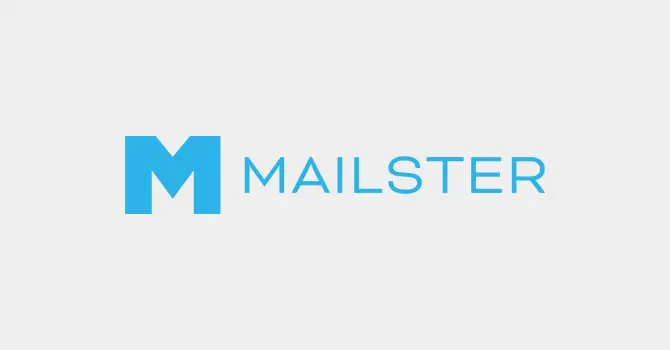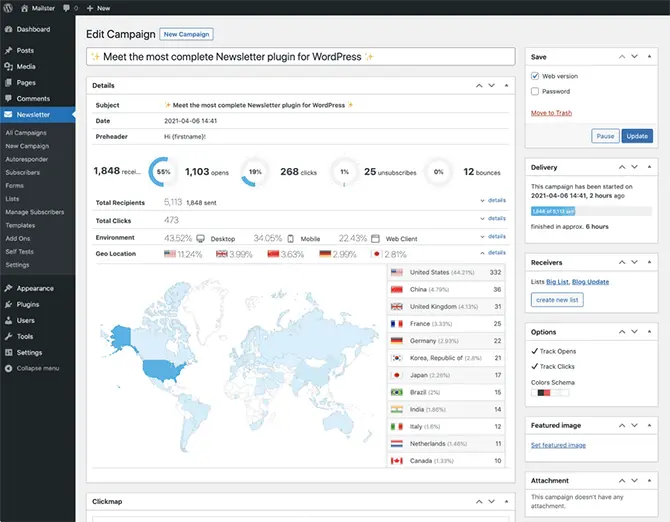
Mailster is a powerful WordPress newsletter plugin designed to help businesses and website owners create, send, and automate email campaigns without leaving the WordPress dashboard. Unlike external email marketing platforms, it integrates natively with WordPress, giving you full control over your subscribers and data.
This plugin is ideal for bloggers, eCommerce store owners, agencies, and marketers who want an affordable, self-hosted email marketing solution. It combines simplicity with advanced features, allowing users to design professional newsletters, set up automation sequences, and track performance analytics directly inside their website.
Mailster is essentially a self-hosted email marketing solution built for WordPress users. It lets you send unlimited campaigns using your own server or through SMTP services like Amazon SES, SendGrid, or Mailgun.
It comes with a drag-and-drop email builder, subscriber management tools, and built-in analytics. Moreover, you can automate campaigns based on user actions, schedule newsletters, and segment subscribers for better targeting. This makes Mailster a great alternative to third-party SaaS tools like Mailchimp or ConvertKit, especially for those who prefer to keep their data in-house.
Mailster – WordPress Newsletter Plugin

Mailster provides everything needed to manage email marketing directly within WordPress. It’s cost-effective, highly customizable, and integrates with popular plugins like WooCommerce, Contact Form 7, and Gravity Forms.
For businesses seeking full control, it removes monthly fees and allows unlimited subscribers as long as the server can handle the volume. Ultimately, Mailster is a perfect choice for WordPress users who want powerful WordPress newsletter plugin capabilities without relying on external platforms.
Key Features of WordPress Newsletter Plugin
Mailster is packed with features that make it a comprehensive and powerful email marketing solution for WordPress. Here are the most important features:
- Drag-and-Drop Email Builder – Easily create professional newsletters without coding using a user-friendly, visual editor.
- Unlimited Subscribers & Campaigns – Unlike SaaS tools, Mailster lets you manage unlimited contacts and send unlimited campaigns, limited only by your server capacity.
- Automation & Autoresponders – Set up triggered emails based on actions like sign-ups, purchases, or specific dates to nurture leads and boost engagement.
- Advanced Segmentation & Targeting – Group subscribers based on interests, behavior, or custom fields for highly personalized campaigns.
- Detailed Analytics & Tracking – Monitor open rates, click-through rates, and unsubscribes directly in the WordPress dashboard for data-driven decisions.
- SMTP & Email Delivery Integration – Connect with Amazon SES, SendGrid, Mailgun, or your own SMTP server for reliable deliverability and lower bounce rates.
- WooCommerce & Form Plugin Integration – Seamlessly collect subscribers from WooCommerce checkout, Contact Form 7, Gravity Forms, and other lead capture tools.
- Responsive Email Templates – Choose from pre-made templates that look great on desktop and mobile devices, helping increase conversions.
- GDPR-Compliant Tools – Easily add consent checkboxes and manage data privacy preferences to stay compliant with regulations.
- Import & Export Subscribers – Quickly migrate lists from other platforms or export data for backup and analysis.
- Multi-User Support – Assign different user roles and permissions, perfect for teams managing campaigns collaboratively.
- Scheduling & Queuing – Control exactly when campaigns are sent, ensuring optimal delivery times for your audience.
Benefits of Using WordPress Newsletter Plugin
Mailster provides a range of advantages that make it a compelling choice for WordPress users. Below are the top benefits:
- Full Control Over Data – Unlike SaaS email tools, you own and manage all subscriber data directly on your WordPress site, ensuring privacy and compliance.
- Cost-Effective Email Marketing – There are no monthly subscriber-based fees, making it far more affordable for businesses with growing lists.
- Unlimited Campaigns & Subscribers – Scale your email marketing efforts without worrying about hitting arbitrary limits.
- Seamless WordPress Integration – Manage everything from one dashboard without needing to log into a separate platform.
- Highly Customizable Templates – Tailor every email to match your brand identity, improving consistency and trust.
- Reliable Deliverability with SMTP – Integrate with services like Amazon SES or Mailgun for better inbox placement and reduced bounce rates.
- Automation for Better Engagement – Send targeted drip campaigns, welcome series, and follow-ups automatically.
- Powerful Analytics – Gain insights into open rates, clicks, and conversions to refine future campaigns.
- One-Time Payment Model – Pay once and use it forever, avoiding recurring subscription costs.
- Team Collaboration – Allow multiple users to work on campaigns with role-based access.
Use Cases of Mailster
Mailster is versatile and works for many types of businesses and websites. Here are the best use cases:
- E-Commerce Stores – Send product promotions, abandoned cart reminders, and post-purchase follow-ups to increase sales.
- Bloggers & Content Creators – Build newsletters to keep readers updated with new posts, guides, and exclusive content.
- Coaches & Consultants – Automate lead nurturing campaigns and deliver valuable resources directly to subscribers.
- Agencies & Freelancers – Manage multiple client campaigns from a single WordPress site, saving time and cost.
- Membership Websites – Send updates, onboarding sequences, and retention campaigns to members.
- Event Organizers – Promote upcoming events, send reminders, and follow-up emails after the event ends.
- SaaS & Startups – Share product updates, feature announcements, and onboarding tips to boost engagement.
- Local Businesses – Build loyalty campaigns, send coupons, and share seasonal offers to drive foot traffic.
Limitations of Using Mailster
Although Mailster is a powerful WordPress newsletter plugin, it does come with some limitations worth considering. Here are the key drawbacks:
- Dependent on Your Hosting Server – Since Mailster is self-hosted, deliverability and performance depend heavily on the quality of your hosting and server resources.
- Requires SMTP Setup for Best Results – To achieve high inbox placement, you must configure an SMTP service like Amazon SES or SendGrid, which adds an extra step for beginners.
- No Native Email Deliverability Guarantee – Unlike SaaS platforms, there’s no built-in infrastructure to ensure deliverability — it relies on your chosen mail service.
- Learning Curve for New Users – Users unfamiliar with WordPress or email marketing may need time to understand list management, automation, and segmentation.
- Limited Built-In Integrations Compared to SaaS Tools – While it integrates with popular WordPress plugins, some external CRM or advanced marketing tools may require manual setup or custom solutions.
- Potential Performance Issues on Shared Hosting – Large email lists can slow down your website if the server lacks resources or is not optimized.
- No Dedicated Cloud-Based Dashboard – All campaign management happens within WordPress, which may be limiting for teams used to standalone SaaS dashboards.
Mailster vs Competitors
When comparing Mailster to SaaS tools like Mailchimp, ConvertKit, or ActiveCampaign, several differences stand out. Below is a comparison sorted by the most crucial factors for businesses:
- Pricing Model – Mailster offers a one-time payment, while competitors typically charge monthly fees that grow as your list size increases.
- Data Ownership & Privacy – With Mailster, you fully control subscriber data on your own server, unlike cloud-based competitors that store data externally.
- Customization & Flexibility – Mailster integrates directly with WordPress and allows deeper customization, whereas SaaS tools have a fixed dashboard with limited design control.
- Scalability – SaaS platforms handle infrastructure and deliverability at scale, while Mailster relies on your server capacity and configuration.
- Deliverability Support – Competitors offer managed deliverability and IP reputation services, while Mailster requires you to configure your SMTP or transactional email provider.
- Ease of Use – Mailchimp and ConvertKit may feel more beginner-friendly, whereas Mailster is ideal for users comfortable with WordPress.
- Integration Ecosystem – SaaS tools have hundreds of ready-made integrations, while Mailster focuses on WordPress-centric integrations like WooCommerce and form plugins.
- Team Collaboration & Cloud Access – Platforms like ActiveCampaign offer multi-user cloud dashboards, while Mailster restricts collaboration to WordPress user roles.
- Automation Depth – Advanced tools like ActiveCampaign offer complex automation workflows, whereas Mailster focuses on essential autoresponders and campaigns.
Minimum Requirements for WordPress Newsletter Plugin
Before installing Mailster, it’s essential to ensure that your website meets the basic technical requirements. Meeting these standards guarantees smooth performance and prevents delivery failures.
- WordPress Version – Requires WordPress 5.0 or higher for full compatibility and security.
- PHP Version – Needs PHP 7.4 or above (PHP 8.0+ highly recommended) for faster processing and better stability.
- MySQL or MariaDB – At least MySQL 5.6+ or MariaDB 10+ to properly store subscriber data and campaign logs.
- Memory Limit – Minimum of 128 MB PHP memory (256 MB recommended for larger lists).
- Web Server Support – Works with Apache or Nginx running on Linux-based hosting for the best performance.
- Cron Jobs – WordPress cron must be enabled, or you should configure a real server cron job for reliable campaign scheduling.
- SSL Certificate – Strongly recommended for secure subscriber data collection and improved email trust.
Recommended Hosting Specification for Mailster
To get the best results, especially if you run high-volume campaigns, choosing the right hosting is crucial. A well-optimized environment ensures faster delivery and fewer email bounces.
- Hosting Type – VPS or Managed WordPress Hosting is recommended for businesses with growing subscriber lists. Shared hosting may work but can limit performance for large campaigns.
- PHP Memory Limit – At least 256 MB or more, which allows Mailster to handle bigger email queues smoothly.
- Execution Time – Set max_execution_time to 300 seconds or more to process large campaigns without timeouts.
- Database Performance – Hosting should provide optimized MySQL or MariaDB with fast query execution for better campaign reporting.
- SMTP Compatibility – Make sure your host allows external SMTP connections to services like Amazon SES, Mailgun, or SendGrid for reliable email delivery.
- Daily Email Limit – Choose a hosting provider that does not restrict outgoing email too heavily, or rely on a third-party SMTP for unlimited sends.
- Dedicated Resources – For lists over 10,000 subscribers, use hosting with dedicated CPU and RAM to avoid delays during campaign processing.
Getting Started with WordPress Newsletter Plugin
Setting up Mailster is straightforward when you follow a structured process. Here’s a step-by-step workflow:
- Install and Activate Mailster
Download the plugin, then go to WordPress Dashboard → Plugins → Add New → Upload Plugin and install it. Activate the plugin once installed. - Configure General Settings
Navigate to Mailster → Settings and set your from name, from email, and reply-to address. Next, choose your preferred sending method (PHP mail, SMTP, or an external provider like Amazon SES or SendGrid). - Create or Import Subscriber Lists
Add subscribers manually, import from a CSV file, or integrate Mailster with WooCommerce, Contact Form 7, or Gravity Forms to automatically capture leads. - Design Your First Campaign
Use Mailster’s drag-and-drop email builder to create a beautiful template. Add text blocks, images, buttons, and dynamic content for personalization. - Set Up Automation & Autoresponders
Create welcome series, post-purchase follow-ups, or event-triggered campaigns. This keeps your audience engaged and nurtures relationships automatically. - Test Your Campaign
Send a test email to yourself and check for formatting, links, and deliverability. Make any necessary adjustments before launching. - Schedule and Send
Choose whether to send immediately or schedule for a future date and time. Mailster also supports queued sending for large lists to avoid server overload. - Monitor Campaign Performance
Track open rates, clicks, bounces, and unsubscribes in the analytics dashboard. Use these insights to optimize future campaigns for better results.
Best Practices for Mailster
To get the most out of Mailster, follow these best practices for improving deliverability, engagement, and conversions:
- Use a Reliable SMTP Provider – Connect Mailster with Amazon SES, SendGrid, or Mailgun for improved inbox delivery.
- Keep Your Lists Clean – Regularly remove inactive subscribers and invalid email addresses to protect sender reputation.
- Segment Your Audience – Group subscribers based on preferences, purchase history, or behavior to send highly targeted campaigns.
- Optimize Subject Lines – Craft compelling, clear subject lines to boost open rates and avoid spam filters.
- Design Mobile-Responsive Templates – Ensure emails look great on smartphones since most users check email on mobile.
- Test Before Sending – Always send test campaigns to check formatting, broken links, and email client compatibility.
- Automate Key Campaigns – Set up welcome emails, abandoned cart reminders, and re-engagement sequences to save time and boost ROI.
- Monitor Analytics Consistently – Analyze open rates, clicks, and conversions to identify what’s working and improve strategy.
- Comply with GDPR & CAN-SPAM – Include clear unsubscribe links and respect user consent to avoid legal issues.
- Update Plugin Regularly – Keep Mailster and WordPress updated to ensure security, compatibility, and access to new features.
Settings & Configurations for Mailster
Properly configuring Mailster ensures optimal email deliverability, better performance, and a seamless experience for subscribers. Taking the time to fine-tune settings will help you avoid spam issues, maintain list quality, and automate campaigns effectively.
- General Settings
Start by setting your from name, from email, and reply-to address. You can also customize your email footer, default language, and time zone. - Delivery Settings
Configure your sending method carefully. You can use PHP mail, but for best deliverability, connect Mailster with an SMTP service like Amazon SES, SendGrid, Mailgun, or Postmark. Additionally, set the maximum emails per hour to avoid server throttling. - List & Subscriber Settings
Enable double opt-in for new subscribers to improve list quality and reduce fake sign-ups. Set default lists for forms, manage subscription confirmation emails, and configure welcome messages for new subscribers. - Template & Design Settings
Choose or customize default templates that align with your brand identity. Adjust typography, colors, and logo placement to create visually appealing campaigns. - Campaign Settings
Decide how campaigns are tracked by enabling open rate and click tracking. You can also configure bounces and unsubscribes to maintain a clean, healthy list. - Automation & Autoresponder Settings
Create automation rules for welcome sequences, drip campaigns, and triggered emails based on user behavior. Send emails at the most effective times. - GDPR & Privacy Settings
Configure privacy compliance by enabling consent checkboxes and setting data retention rules to stay compliant with GDPR, CAN-SPAM, and email. - Integration Settings
Connect Mailster with WooCommerce, Contact Form 7, Gravity Forms, or membership plugins to automatically capture leads from your site’s forms. - Cron Job & Queue Settings
Set up cron jobs or use WordPress’s built-in scheduler to control when emails are sent. This is essential for high-volume campaigns to avoid server overload.
Tips to Use Mailster
Using Mailster effectively requires strategy, not just installation. Here are the best tips to maximize results:
- Use a Reliable SMTP Provider – Connect Mailster with Amazon SES, Mailgun, SendGrid, or Postmark to improve deliverability.
- Segment Your Subscribers – Create targeted lists based on user behavior, demographics, or past purchases to boost open and click-through rates.
- Leverage Automation – Set up welcome series, abandoned cart reminders, and re-engagement campaigns to nurture leads customers.
- A/B Test Your Campaigns – Experiment with subject lines, email layouts, and CTAs to determine what resonates best with your audience.
- Optimize for Mobile – Always preview emails on mobile devices, as most users open campaigns on their phones.
- Clean Your List Regularly – Remove inactive subscribers and hard bounces to maintain sender reputation and improve overall engagement rates.
- Schedule Campaigns at Optimal Times – Test different sending times and use Mailster’s scheduling feature to hit peak inbox hours.
- Enable Double Opt-In – Reduce spam complaints and improve list quality by confirming subscribers’ intent to join.



